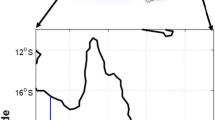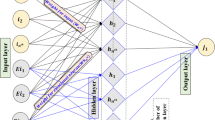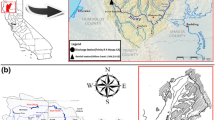Abstract
To achieve a robust data-driven flood forecasting model, features such as fast learning, appropriate training using insufficient data and reliable prediction of flood flows are of essential importance. These models also have notable vulnerabilities such as decreased accuracy in forecasting peak discharges, challenging simulation of rainy events, performance deterioration in confronting with inadequate training data and weakness due to reduced number of training epochs. In this paper, the supervised brain emotional learning (SBEL) neural network has been used in daily rainfall–runoff modeling of the Dez Dam watershed in the southwest of Iran, as its first application in the field of hydrology. SBEL is a supervised neurocomputing model inspired by the limbic system in the mammalian brain. To create the right responses, the SBEL models the processing of emotional stimuli and the inhibitory mechanism of incorrect responses to stimuli in the emotional brain. The performance of SBEL was compared to the well-known multilayer perceptron (MLP) with 15–8–1 architecture, through different perspectives. The SBEL outperforms MLP in peak flow prediction, limiting the training epochs, reducing the training samples and predictions of rainy events, while improving the mean relative error by 21%, 59.4%, 74.5% and 14.4%, respectively. By placing reduced training data in dry, normal and wet periods, it has been observed that SBEL has more generalization ability in all flow regimes. Overall, the use of this type of emotional intelligence-based model can be of particular interest in developing reliable early flood forecasting and warning systems.















Similar content being viewed by others
References
Hadid B, Duviella E, Lecoeuche S (2020) Data-driven modeling for river flood forecasting based on a piecewise linear ARX system identification. J Process Control 86:44–56. https://doi.org/10.1016/j.jprocont.2019.12.007
Pandhiani SM, Sihag P, Shabri AB et al (2020) Time-series prediction of streamflows of Malaysian rivers using data-driven techniques. J Irrig Drain Eng 146:4020013. https://doi.org/10.1061/(ASCE)IR.1943-4774.0001463
Maier HR, Kapelan Z, Kasprzyk J et al (2014) Evolutionary algorithms and other metaheuristics in water resources: current status, research challenges and future directions. Environ Model Softw 62:271–299. https://doi.org/10.1016/j.envsoft.2014.09.013
Maier HR, Dandy GC (2000) Neural networks for the prediction and forecasting of water resources variables: a review of modelling issues and applications. Environ Model Softw 15:101–124. https://doi.org/10.1016/S1364-8152(99)00007-9
Lipiwattanakarn S, Sriwongsitanon N, Saengsawang S (2004) Improving neural network model performance in runoff estimation by using an antecedent precipitation index. J Hydrosci Hydraul Eng 22:141–154
Clarke RT (1994) Statistical modelling in hydrology. Wiley, Chichester, UK
Liu T, Wei H, Zhang C, Zhang K (2017) Time series forecasting based on wavelet decomposition and feature extraction. Neural Comput Appl 28:183–195. https://doi.org/10.1007/s00521-016-2306-8
Mirabbasi R, Kisi O, Sanikhani H, Meshram SG (2019) Monthly long-term rainfall estimation in Central India using M5Tree, MARS, LSSVR, ANN and GEP models. Neural Comput Appl 31:6843–6862. https://doi.org/10.1007/s00521-018-3519-9
Yadav B, Ch S, Mathur S, Adamowski J (2016) Discharge forecasting using an online sequential extreme learning machine (OS-ELM) model: a case study in Neckar River, Germany. Measurement 92:433–445. https://doi.org/10.1016/j.measurement.2016.06.042
Liang Z, Li Y, Hu Y et al (2018) A data-driven SVR model for long-term runoff prediction and uncertainty analysis based on the Bayesian framework. Theor Appl Climatol 133:137–149. https://doi.org/10.1007/s00704-017-2186-6
Koycegiz C, Buyukyildiz M (2019) Calibration of SWAT and two data-driven models for a data-scarce mountainous headwater in semi-arid Konya closed basin. Water 11:147. https://doi.org/10.3390/w11010147
He Z, Wen X, Liu H, Du J (2014) A comparative study of artificial neural network, adaptive neuro fuzzy inference system and support vector machine for forecasting river flow in the semiarid mountain region. J Hydrol 509:379–386. https://doi.org/10.1016/j.jhydrol.2013.11.054
Adamowski J, Sun K (2010) Development of a coupled wavelet transform and neural network method for flow forecasting of non-perennial rivers in semi-arid watersheds. J Hydrol 390:85–91. https://doi.org/10.1016/j.jhydrol.2010.06.033
Wagena MB, Goering D, Collick AS et al (2020) Comparison of short-term streamflow forecasting using stochastic time series, neural networks, process-based, and Bayesian models. Environ Model Softw 126:104669. https://doi.org/10.1016/j.envsoft.2020.104669
Chang TK, Talei A, Quek C, Pauwels VRN (2018) Rainfall-runoff modelling using a self-reliant fuzzy inference network with flexible structure. J Hydrol 564:1179–1193. https://doi.org/10.1016/j.jhydrol.2018.07.074
Yolcu OC, Bas E, Egrioglu E, Yolcu U (2020) A new intuitionistic fuzzy functions approach based on hesitation margin for time-series prediction. Soft Comput 24:8211–8222. https://doi.org/10.1007/s00500-019-04432-2
Danandeh Mehr A, Nourani V, Kahya E et al (2018) Genetic programming in water resources engineering: a state-of-the-art review. J Hydrol 566:643–667. https://doi.org/10.1016/j.jhydrol.2018.09.043
Feng Z, k., Niu W j., Tang Z y, et al (2020) Monthly runoff time series prediction by variational mode decomposition and support vector machine based on quantum-behaved particle swarm optimization. J Hydrol 583:124627. https://doi.org/10.1016/j.jhydrol.2020.124627
Kisi O, Cimen M (2011) A wavelet-support vector machine conjunction model for monthly streamflow forecasting. J Hydrol 399:132–140. https://doi.org/10.1016/j.jhydrol.2010.12.041
Nourani V, Kisi O, Komasi M (2011) Two hybrid artificial intelligence approaches for modeling rainfall–runoff process. J Hydrol 402:41–59. https://doi.org/10.1016/j.jhydrol.2011.03.002
Sahay RR, Srivastava A (2014) Predicting monsoon floods in rivers embedding wavelet transform, genetic algorithm and neural network. Water Resour Manag 28:301–317. https://doi.org/10.1007/s11269-013-0446-5
ASCE (2000) Artificial neural networks in hydrology. II: hydrologic applications. J Hydrol Eng 5:124
Muñoz P, Orellana-Alvear J, Willems P, Célleri R (2018) Flash-flood forecasting in an Andean mountain catchment—development of a step-wise methodology based on the random forest algorithm. Water 10:1519. https://doi.org/10.3390/w10111519
Pradhan P, Tingsanchali T, Shrestha S (2020) Evaluation of soil and water assessment tool and artificial neural network models for hydrologic simulation in different climatic regions of Asia. Sci Total Environ 701:134308. https://doi.org/10.1016/j.scitotenv.2019.134308
Choong CE, Ibrahim S, El-Shafie A (2020) Artificial Neural Network (ANN) model development for predicting just suspension speed in solid-liquid mixing system. Flow Meas Instrum 71:101689. https://doi.org/10.1016/j.flowmeasinst.2019.101689
Abrahart RJ, Anctil F, Coulibaly P et al (2012) Two decades of anarchy? Emerging themes and outstanding challenges for neural network river forecasting. Prog Phys Geogr 36:480–513. https://doi.org/10.1177/0309133312444943
Haykin S (1999) Neural networks: a comprehensive foundation. Prentice Hall
Page GF, Gomm JB, Williams D (1993) Application of neural networks to modelling and control. Chapman & Hall New York, NY
Anctil F, Perrin C, Andréassian V (2004) Impact of the length of observed records on the performance of ANN and of conceptual parsimonious rainfall-runoff forecasting models. Environ Model Softw 19:357–368. https://doi.org/10.1016/S1364-8152(03)00135-X
Cigizoglu HK (2005) Application of generalized regression neural networks to intermittent flow forecasting and estimation. J Hydrol Eng 10:336–341. https://doi.org/10.1061/(ASCE)1084-0699(2005)10:4(336)
Danandeh Mehr A, Kahya E, Şahin A, Nazemosadat MJ (2015) Successive-station monthly streamflow prediction using different artificial neural network algorithms. Int J Environ Sci Technol 12:2191–2200. https://doi.org/10.1007/s13762-014-0613-0
Fernando DAK, Jayawardena AW (1998) Runoff forecasting using RBF networks with OLS algorithm. J Hydrol Eng 3:203–209. https://doi.org/10.1061/(asce)1084-0699(1998)3:3(203)
Kagoda PA, Ndiritu J, Ntuli C, Mwaka B (2010) Application of radial basis function neural networks to short-term streamflow forecasting. Phys Chem Earth, Parts A/B/C 35:571–581. https://doi.org/10.1016/j.pce.2010.07.021
Moradkhani H, Hsu KL, Gupta HV, Sorooshian S (2004) Improved streamflow forecasting using self-organizing radial basis function artificial neural networks. J Hydrol 295:246–262. https://doi.org/10.1016/j.jhydrol.2004.03.027
Mutlu E, Chaubey I, Hexmoor H, Bajwa SG (2008) Comparison of artificial neural network models for hydrologic predictions at multiple gauging stations in an agricultural watershed. Hydrol Process An Int J 22:5097–5106. https://doi.org/10.1002/hyp.7136
Zakermoshfegh M, Ghodsian M, Salehi Neishabouri SAA, Shakiba M (2008) River flow forecasting using neural networks and auto-calibrated NAM model with shuffled complex evolution. J Appl Sci 8:1487–1494. https://doi.org/10.3923/jas.2008.1487.1494
Yaseen ZM, El-Shafie A, Jaafar O et al (2015) Artificial intelligence based models for stream-flow forecasting: 2000–2015. J Hydrol 530:829–844. https://doi.org/10.1016/j.jhydrol.2015.10.038
Aytek A, Alp M (2008) An application of artificial intelligence for rainfall-runoff modeling. J Earth Syst Sci 117:145–155. https://doi.org/10.1007/s12040-008-0005-2
Partal T (2009) River flow forecasting using different artificial neural network algorithms and wavelet transform. Can J Civ Eng 36:26–38. https://doi.org/10.1139/L08-090
Quilty J, Adamowski J (2018) Addressing the incorrect usage of wavelet-based hydrological and water resources forecasting models for real-world applications with best practices and a new forecasting framework. J Hydrol 563:336–353. https://doi.org/10.1016/j.jhydrol.2018.05.003
Quilty J, Adamowski J, Boucher M (2019) A stochastic data-driven ensemble forecasting framework for water resources: a case study using ensemble members derived from a database of deterministic wavelet-based models. Water Resour Res 55:175–202. https://doi.org/10.1029/2018WR023205
Nourani V (2017) An emotional ANN (EANN) approach to modeling rainfall-runoff process. J Hydrol 544:267–277. https://doi.org/10.1016/j.jhydrol.2016.11.033
Yaseen ZM, Allawi MF, Yousif AA et al (2018) Non-tuned machine learning approach for hydrological time series forecasting. Neural Comput Appl 30:1479–1491. https://doi.org/10.1007/s00521-016-2763-0
Yaseen ZM, Awadh SM, Sharafati A, Shahid S (2018) Complementary data-intelligence model for river flow simulation. J Hydrol 567:180–190. https://doi.org/10.1016/j.jhydrol.2018.10.020
Araghinejad S, Fayaz N, Hosseini-Moghari SM (2018) Development of a hybrid data driven model for hydrological estimation. Water Resour Manag 32:3737–3750. https://doi.org/10.1007/s11269-018-2016-3
Darbandi S, Pourhosseini FA (2018) River flow simulation using a multilayer perceptron-firefly algorithm model. Appl Water Sci 8:85. https://doi.org/10.1007/s13201-018-0713-y
Ni L, Wang D, Singh VP et al (2019) Streamflow and rainfall forecasting by two long short-term memory-based models. J Hydrol 124296
Yu X, Yang J, Xie Z (2014) Training SVMs on a bound vectors set based on Fisher projection. Front Comput Sci 8:793–806
Yu X, Chu Y, Jiang F et al (2018) SVMs classification based two-side cross domain collaborative filtering by inferring intrinsic user and item features. Knowledge-Based Syst 141:80–91
Yu X, Jiang F, Du J, Gong D (2019) A cross-domain collaborative filtering algorithm with expanding user and item features via the latent factor space of auxiliary domains. Pattern Recognit 94:96–109
Brent RP (1991) Fast training algorithms for multilayer neural nets. IEEE Trans Neural Networks 2:346–354. https://doi.org/10.1109/72.97911
Gori M, Tesi A (1992) On the problem of local minima in backpropagation. IEEE Trans Pattern Anal Mach Intell 14:76–86. https://doi.org/10.1109/34.107014
Sudheer KP, Nayak PC, Ramasastri KS (2003) Improving peak flow estimates in artificial neural network river flow models. Hydrol Process 17:677–686. https://doi.org/10.1002/hyp.5103
Bossley KM (1997) Neurofuzzy modelling approaches in system identification. University of Southampton
Parsapoor M, Bilstrup U (2013) Chaotic time series prediction using brain emotional learning based recurrent fuzzy system (BELRFS). Int J Reason Intell Syst 5:113–126. https://doi.org/10.1504/IJRIS.2013.057273
Kalteh AM (2013) Monthly river flow forecasting using artificial neural network and support vector regression models coupled with wavelet transform. Comput Geosci 54:1–8. https://doi.org/10.1016/j.cageo.2012.11.015
Nourani V, Baghanam AH, Adamowski J, Kisi O (2014) Applications of hybrid wavelet–artificial intelligence models in hydrology: a review. J Hydrol 514:358–377. https://doi.org/10.1016/j.jhydrol.2014.03.057
Shoaib M, Shamseldin AY, Melville BW, Khan MM (2016) A comparison between wavelet based static and dynamic neural network approaches for runoff prediction. J Hydrol 535:211–225. https://doi.org/10.1016/j.jhydrol.2016.01.076
Babaie T, Karimizandi R, Lucas C (2008) Learning based brain emotional intelligence as a new aspect for development of an alarm system. Soft Comput 12:857–873. https://doi.org/10.1007/s00500-007-0258-8
Khashman A (2008) A modified backpropagation learning algorithm with added emotional coefficients. IEEE Trans Neural Netw 19:1896–1909. https://doi.org/10.1109/TNN.2008.2002913
Morén J (2002) Emotion and learning: A computational model of the amygdala. Ph.D. Thesis, Lund Univ Lund, Sweden
Lotfi E, Khosravi A, Akbarzadeh-T MR, Nahavandi S (2014) Wind power forecasting using emotional neural networks. In: 2014 IEEE international conference on systems, man, and cybernetics (SMC). IEEE, pp 311–316
Goleman D (1996) Emotional intelligence: why it can matter more than IQ. Bloomsbury Publishing
LeDoux JE (1991) Emotion and the limbic system concept. Concepts Neurosci 2:169–199
Abdi J, Moshiri B, Abdulhai B, Sedigh AK (2012) Forecasting of short-term traffic-flow based on improved neurofuzzy models via emotional temporal difference learning algorithm. Eng Appl Artif Intell 25:1022–1042
Lucas C, Abbaspour A, Gholipour A et al (2003) Enhancing the performance of neurofuzzy predictors by emotional learning algorithm. INFORMATICA-LJUBLJANA- 27:137–146
Parsapoor M, Lucas C, Setayeshi S (2008) Reinforcement_recurrent fuzzy rule based system based on brain emotional learning structure to predict the complexity dynamic system. In: 2008 third international conference on digital information management. IEEE, pp 25–32
Parsapoor M, Bilstrup U (2012) Brain emotional learning based fuzzy inference system (BELFIS) for solar activity forecasting. In: 2012 IEEE 24th international conference on tools with artificial intelligence. IEEE, pp 532–539
Parsapoor M, Bilstrup U (2012) Neuro-fuzzy models, BELRFS and LoLiMoT, for prediction of chaotic time series. In: 2012 international symposium on innovations in intelligent systems and applications. IEEE, pp 1–5
Pavlos GP, Iliopoulos AC, Tsoutsouras VG et al (2011) First and second order non-equilibrium phase transition and evidence for non-extensive Tsallis statistics in Earth’s magnetosphere. Phys A Stat Mech its Appl 390:2819–2839. https://doi.org/10.1016/j.physa.2011.03.005
Gholipour A, Lucas C, Shahmirzadi D (2004) Purposeful prediction of space weather phenomena by simulated emotional learning. Int J Model Simul 24:65–72. https://doi.org/10.1080/02286203.2004.11442288
Sheikholeslami N, Shahmirzadi D, Semsar E et al (2006) Applying brain emotional learning algorithm for multivariable control of HVAC systems. J Intell Fuzzy Syst 17:35–46
Mehrabian AR, Lucas C, Roshanian J (2006) Aerospace launch vehicle control: an intelligent adaptive approach. Aerosp Sci Technol 10:149–155. https://doi.org/10.1016/j.ast.2005.11.002
Milasi RM, Lucas C, Araabi BN (2005) Intelligent modeling and control of washing machine using LLNF modeling and modified BELBIC. In: 2005 international conference on control and automation. IEEE, pp 812–817
Liu L, Moayedi H, Rashid ASA et al (2020) Optimizing an ANN model with genetic algorithm (GA) predicting load-settlement behaviours of eco-friendly raft-pile foundation (ERP) system. Eng Comput 36:421–433. https://doi.org/10.1007/s00366-019-00767-4
Hornik K, Stinchcombe M, White H (1989) Multilayer feedforward networks are universal approximators. Neural Netw 2:359–366. https://doi.org/10.1016/0893-6080(89)90020-8
Beheshti Z, Firouzi M, Shamsuddin SM et al (2016) A new rainfall forecasting model using the CAPSO algorithm and an artificial neural network. Neural Comput Appl 27:2551–2565. https://doi.org/10.1007/s00521-015-2024-7
Badrzadeh H, Sarukkalige R, Jayawardena AW (2015) Hourly runoff forecasting for flood risk management: Application of various computational intelligence models. J Hydrol 529:1633–1643. https://doi.org/10.1016/j.jhydrol.2015.07.057
Yaseen ZM, El-Shafie A, Afan HA et al (2016) RBFNN versus FFNN for daily river flow forecasting at Johor River, Malaysia. Neural Comput Appl 27:1533–1542. https://doi.org/10.1007/s00521-015-1952-6
Brown M, Harris CJ (1995) A perspective and critique of adaptive neurofuzzy systems used for modelling and control applications. Int J Neural Syst 6:197–220. https://doi.org/10.1142/S0129065795000159
Rumelhart DE, Hinton GE, Williams RJ (1986) Learning representations by back-propagating errors. Nature 323:533–536. https://doi.org/10.1016/j.measurement.2017.09.025
Lotfi E, Akbarzadeh-T MR (2013) Brain emotional learning-based pattern recognizer. Cybern Syst 44:402–421. https://doi.org/10.1080/01969722.2013.789652
LeDoux JE (1996) The emotional brain. Simon & Schuster
Morén J, Balkenius C (2000) A computational model of emotional learning in the amygdala. From Anim to Animat 6:115–124
LeDoux JE (2000) Emotion circuits in the brain. Annu Rev Neurosci 23:155–184. https://doi.org/10.1007/978-981-13-3320-0_10
Phelps EA, LeDoux JE (2005) Contributions of the amygdala to emotion processing: from animal models to human behavior. Neuron 48:175–187. https://doi.org/10.1016/j.neuron.2005.09.025
Balkenius C, Morén J (2001) Emotional learning: a computational model of the amygdala. Cybern Syst 32:611–636. https://doi.org/10.1080/01969720118947
Elliott R, Dolan RJ, Frith CD (2000) Dissociable functions in the medial and lateral orbitofrontal cortex: evidence from human neuroimaging studies. Cereb cortex 10:308–317. https://doi.org/10.1093/cercor/10.3.308
Lotfi E, Akbarzadeh TMR (2012) Supervised brain emotional learning. In: The 2012 international joint conference on neural networks (IJCNN). IEEE, pp 1–6
Lotfi E, Akbarzadeh-T MR (2014) Practical emotional neural networks. Neural Netw 59:61–72. https://doi.org/10.1016/j.neunet.2014.06.012
Lo Conti F, Hsu K-L, Noto LV, Sorooshian S (2014) Evaluation and comparison of satellite precipitation estimates with reference to a local area in the Mediterranean Sea. Atmos Res 138:189–204. https://doi.org/10.1016/j.atmosres.2013.11.011
Griggs DJ, Noguer M (2002) Climate change 2001: the scientific basis. Contribution of working group I to the third assessment report of the intergovernmental panel on climate change. Weather 57:267–269. https://doi.org/10.1256/004316502320517344
Pincus R, Batstone CP, Hofmann RJP et al (2008) Evaluating the present-day simulation of clouds, precipitation, and radiation in climate models. J Geophys Res Atmos 113:1–10. https://doi.org/10.1029/2007JD009334
Wehner MF (2013) Very extreme seasonal precipitation in the NARCCAP ensemble: model performance and projections. Clim Dyn 40:59–80. https://doi.org/10.1007/s00382-012-1393-1
Taylor KE (2001) Summarizing multiple aspects of model performance in a single diagram. J Geophys Res Atmos 106:7183–7192. https://doi.org/10.1029/2000JD900719
Hintze JL, Nelson RD (1998) Violin plots: a box plot-density trace synergism. Am Stat 52:181–184. https://doi.org/10.1080/00031305.1998.10480559
Funding
No funding was received for conducting this study.
Author information
Authors and Affiliations
Corresponding author
Ethics declarations
Conflict of interest
The authors declare that they have no conflict of interest.
Additional information
Publisher's Note
Springer Nature remains neutral with regard to jurisdictional claims in published maps and institutional affiliations.
Rights and permissions
About this article
Cite this article
Parvinizadeh, S., Zakermoshfegh, M. & Shakiba, M. A simple and efficient rainfall–runoff model based on supervised brain emotional learning. Neural Comput & Applic 34, 1509–1526 (2022). https://doi.org/10.1007/s00521-021-06475-9
Received:
Accepted:
Published:
Issue Date:
DOI: https://doi.org/10.1007/s00521-021-06475-9




